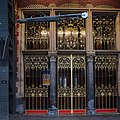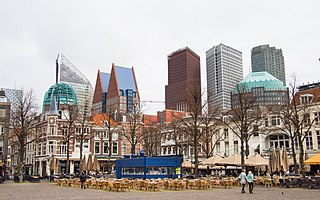
The Hague is the capital city of the South Holland province of the Netherlands. With a population of over half a million, it is the third-largest city in the Netherlands. Situated on the west coast facing the North Sea, The Hague is the country's administrative centre and its seat of government, and while the official capital of the Netherlands is Amsterdam, The Hague has been described as the country's de facto capital since the time of the Dutch Republic.

Baarn is a municipality and a town in the Netherlands, near Hilversum in the province of Utrecht.
The National Railway Company of Belgium is the national railway company of Belgium. The company formally styles itself using the Dutch and French abbreviations NMBS/SNCB. The corporate logo designed in 1936 by Henry van de Velde consists of the linguistically neutral letter B in a horizontal oval.

The HSL-Zuid, is a 125 kilometre-long Dutch high-speed railway line running between the Amsterdam metropolitan area and the Belgian border, with a branch to Breda, North Brabant. Together with the Belgian HSL 4 it forms the Schiphol–Antwerp high-speed railway. Originally scheduled to be in service by 2007, the first public operations began on 7 September 2009, after a ceremony on 6 September.

The Railway Museum in Utrecht is the Dutch national railway museum. It was established in 1927 and since 1954 has been housed in the former Maliebaan station.

Amsterdam Centraal station is the largest railway station in Amsterdam, North Holland, the Netherlands. A major international railway hub, it is used by 192,000 passengers a day, making it the second busiest railway station in the country after Utrecht Centraal and the most visited Rijksmonument of the Netherlands.

Den Haag Centraal is the largest railway station in the city of The Hague in South Holland, Netherlands, and with twelve tracks, the largest terminal station in the Netherlands. The railway station opened in 1973, adjacent to its predecessor: Den Haag Staatsspoor, which was subsequently demolished. It is the western terminus of the Gouda–Den Haag railway.

Antwerpen-Centraal railway station is the main railway station in Antwerp, Belgium. It is one of the most important hubs in the country and is one of the four Belgian stations on the high-speed rail network. From 1873 to early 2007, it was a terminal station. The current building, designed by the architect Louis Delacenserie, was constructed between 1895 and 1905. On 23 March 2007, a tunnel with two continuous tracks was opened under part of the city and under the station. The train services are operated by the National Railway Company of Belgium (NMBS/SNCB).

Rail transport in the Netherlands uses a dense railway network which connects nearly all major towns and cities. There are as many train stations as there are municipalities in the Netherlands. The network totals 3,223 route km (2,003 mi) on 6,830 kilometres (4,240 mi) of track; a line may run both ways, or two lines may run on major routes. Three-quarters of the lines have been electrified.

Nieuw-Vennep is a railway station in Nieuw-Vennep, Netherlands located on the Weesp–Leiden railway. It the second station in Nieuw Vennep; there existed an earlier one on the Hoofddorp–Leiden railway. This station opened in 1912 and closed in 1936.

Den Haag HS, an abbreviation of the original name Den Haag Hollands Spoor, is the oldest train station in The Hague, South Holland, Netherlands, located on the Amsterdam–Haarlem–Rotterdam railway. It is the second main station in The Hague and, unlike The Hague Central Station, it is not a terminus station. The name of the station is derived from the former Hollandsche IJzeren Spoorweg-Maatschappij (HIJSM) which was the first Dutch railway company.

Baarn is a railway station on the Amsterdam–Zutphen railway and the Den Dolder–Baarn railway located in Baarn, Netherlands. The station is operated by the Nederlandse Spoorwegen (NS). The station was opened on 10 June 1874.
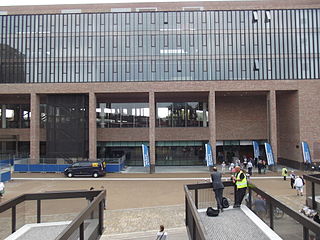
Breda railway station is a railway station in Breda in North Brabant, Netherlands. It is situated on the Breda–Rotterdam railway, the Roosendaal–Breda railway and the Breda–Eindhoven railway.

Rotterdam Centraal station is the main railway station of the city Rotterdam in South Holland, Netherlands. The station received an average of 112,000 passengers daily in 2019. The current station building, located at Station Square, was officially opened in March 2014.
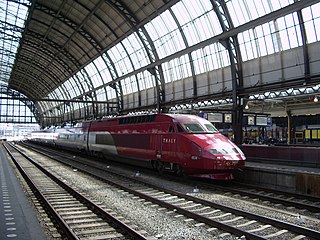
High-speed rail service in the Netherlands started on 13 December 2009 with the dedicated HSL-Zuid line that connects the Randstad via Brussels to the European high-speed rail network. In later years improved traditional rail sections were added to the high-speed network. Proposals for more dedicated high-speed lines were deemed too costly; plans for the HSL-Oost to Germany were mothballed and instead of the Zuiderzeelijn the less ambitious Hanzelijn was built to enable future high-speed service between the northern provinces and the Randstad.
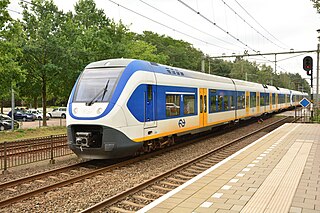
The Sprinter Lighttrain or SLT is an Electric Multiple Unit (EMU) train type operated by the Nederlandse Spoorwegen in the Netherlands. They were built from 2007 to 2012 by Bombardier (2400) and Siemens (2600). It is the successor of the Sprinter SGM train type.

The Amsterdam–Schiphol railway is an important 17 kilometre long railway line in the Netherlands that connects Amsterdam with Amsterdam Airport Schiphol, and allows trains to continue to Leiden, The Hague, and Rotterdam.
The Lage Landen Lijn was a proposed international rail service between The Hague and Brussels, which was to be introduced on 15 December 2013.

Intercity Direct is a Dutch higher-speed train service operating on the HSL-Zuid, connecting Amsterdam Centraal to Schiphol Airport, Rotterdam Centraal and Breda. In December 2013, Fyra was rebranded to Intercity Direct. It is part of NS International.

NS Stations is a Dutch company that owns and manages over 400 railway stations in the Netherlands. It is a subsidiary of national rail operator Nederlandse Spoorwegen (NS). A subsidiary company of NS Stations is NS Stations Retailbedrijf, which uses the brands Automaten, Brasserie Het Station, Burger King, Café T, Café T espresso, C'est du pain, HEMA, Kiosk, La Place, mr. Pizza, Pizza Hut, Restauratie, Rituals, Smullers, Swirl's, and Wizzl, and owns Stationsfoodstore, which is an Albert Heijn franchise operating about 22 "AH to go" convenience stores on stations. Wizzl also sells train tickets. They are typically at small stations which have no separate ticket window or counter; an exception is Rotterdam, with a Wizzl at the back side of the station, while separate ticket windows are at the front side only.


